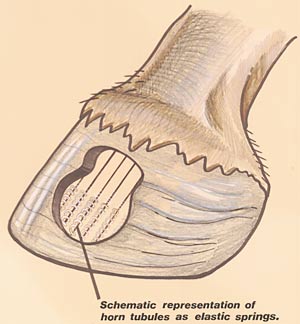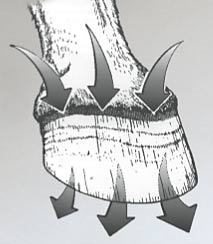 |
 |
|
The Science Behind Modern Hoof Sealants!
by Dr. M. J. Pautienis and Dr. Richard Shakalis
researchers for SBS Equine Products
Video Support for this Article
 For hundreds of years people have seen the wisdom of coating horses’
hooves with various substances for their protection and to maintain flexibility. Pine tar, paraffin, oils and salves have been passed down from one
generation to the next with varying degrees of success. The basic scientific principles they were trying to achieve, maintaining the internal moisture of the
hoof wall while repelling harmful substances are as valid today as they were then. To understand why the modern hoof sealants work so well, let’s
review some basic biology and function of the hoof. For hundreds of years people have seen the wisdom of coating horses’
hooves with various substances for their protection and to maintain flexibility. Pine tar, paraffin, oils and salves have been passed down from one
generation to the next with varying degrees of success. The basic scientific principles they were trying to achieve, maintaining the internal moisture of the
hoof wall while repelling harmful substances are as valid today as they were then. To understand why the modern hoof sealants work so well, let’s
review some basic biology and function of the hoof.
The hoof wall is the weight bearing structure of the hoof and it is composed of thousands of tiny  hollow fibers called tubules. These tubules run
vertically from the coronary band and are cemented together with a protein substance called keratin (see figure one). Layer upon layer of these tubules act effectively as springs
to absorb tremendous amounts of concussive force while retaining the necessary tensile strength. The elasticity of these tubules and the hoof wall in general is dependent on its internal
moisture content. This moisture is not simply water, but a mix of salts and electrolytes much like that found in an I.V. solution. Without this
essential moisture, the hoof wall would dry up, crack, become brittle and generally fail at its job of a leaf spring/shock absorber. Too much moisture, on the other hand, can make a hoof
too soft, mushy and fail to absorb its concussive load. We now understand that the ideal hoof conditioner maintains the natural moisture balance found within the hoof wall. hollow fibers called tubules. These tubules run
vertically from the coronary band and are cemented together with a protein substance called keratin (see figure one). Layer upon layer of these tubules act effectively as springs
to absorb tremendous amounts of concussive force while retaining the necessary tensile strength. The elasticity of these tubules and the hoof wall in general is dependent on its internal
moisture content. This moisture is not simply water, but a mix of salts and electrolytes much like that found in an I.V. solution. Without this
essential moisture, the hoof wall would dry up, crack, become brittle and generally fail at its job of a leaf spring/shock absorber. Too much moisture, on the other hand, can make a hoof
too soft, mushy and fail to absorb its concussive load. We now understand that the ideal hoof conditioner maintains the natural moisture balance found within the hoof wall.
Where does this important moisture come from? The hoof is designed to receive at least 90 percent of its moisture from within, from the blood and lymph vessels, and a small percentage from
the sole. Modern bonded sealants are so effective because they stop the evaporation of this
essential moisture from escaping the hoof wall. Attempting to moisturize the hoof wall with grease
or salve is mostly futile because the hoof wall is virtually non-absorbent. This is why using hoof
conditioners and dressings that contain vitamins or proteins are a complete waste of time. To be of
any benefit, proteins and vitamins have to pass through the digestive system and be broken down
into useful building blocks by digestive enzymes. Putting vitamins and protein on the hoof wall
makes as much sense as trying to eat by sticking your hand in a bowl of soup. The coronary band
is the only place where products meant to condition or increase hoof growth should be applied, and
even care should be taken here. This is where, along with the sole, transpiration or “breathing” occurs (see figure 2).
You may ask, “Why don’t wild horses have all of these hoof problems? Why do I need hoof  protection if I don’t have any hoof problems now?” Good
questions whose answers lie in domestication of the horse. The periople is the protective covering that evolved to contain natural body fluids within the hoof wall while repelling harmful
contaminants. Thus the hoof actually has its own natural, delicate hoof sealant. This natural sealant serves wild horses
well, but it is usually lost in a domestic environment. It is inadvertently removed during the shoeing process when the hoof is trimmed, balanced, leveled and shod. To compound
the problem further, the domestic horse can no longer roam free over miles of open space but is confined to smaller pastures, paddocks, and stalls. Now, with little or no natural
sealant left and with the horn tubules opened from nail holes and rasping, hooves are exposed to higher concentrations of destructive uric acid and other
contaminants. With the protective outer covering removed, the introduction of these agents into the
hoof wall can lead to breakdown of its protein, keratin. It is important to remember that because
the hoof is protein, it is potentially biodegradable. Domesticated horses need a hoof conditioner that effectively replaces the periople. protection if I don’t have any hoof problems now?” Good
questions whose answers lie in domestication of the horse. The periople is the protective covering that evolved to contain natural body fluids within the hoof wall while repelling harmful
contaminants. Thus the hoof actually has its own natural, delicate hoof sealant. This natural sealant serves wild horses
well, but it is usually lost in a domestic environment. It is inadvertently removed during the shoeing process when the hoof is trimmed, balanced, leveled and shod. To compound
the problem further, the domestic horse can no longer roam free over miles of open space but is confined to smaller pastures, paddocks, and stalls. Now, with little or no natural
sealant left and with the horn tubules opened from nail holes and rasping, hooves are exposed to higher concentrations of destructive uric acid and other
contaminants. With the protective outer covering removed, the introduction of these agents into the
hoof wall can lead to breakdown of its protein, keratin. It is important to remember that because
the hoof is protein, it is potentially biodegradable. Domesticated horses need a hoof conditioner that effectively replaces the periople.
Your grandfather and his grandfather before him intuitively used a type of hoof conditioner called
pine tar. This product acted as a precursor to the modern sealants as it helped to retain moisture in
the hoof wall. Pine tar, unfortunately, had its drawbacks, but Grandpa was on the right track.
Later came various products that contained oils, paraffin derivatives (wax) and petroleum-based ingredients that were used with limited success to coat the hoof and fill in the nail holes.
Hoof conditioners containing tar, paraffin, petroleum derivatives or especially protein and vitamins
are not inert and tend to breakdown with time when exposed to the environment. These dressings
are usually sticky, and as such, attract contaminants instead of repelling them. Their applications
actually may be counter-productive because they can serve as a bacterial and/or fungal growth medium when they fester in a small crack or nail hole. These organisms produce enzymes and
exotoxins that can break down collagen and protein in the hoof wall. If you do not get hoof wall
disease, the least that can happen is that the hoof can get soft and punky at the nail holes. If this
happens, your horse will throw more than his fair share of shoes. The ideal hoof conditioner should be stable when cured, able to seal out harmful contaminants and resistant to abrasion.
Other added ingredients found in some hoof conditioners, formaldehyde and acetone, are powerful
drying agents and can be downright harmful to horses, humans and the environment. Their use has
been associated with cancer and liver damage. Use them with caution, or better yet, not at all.
Further, these sealants or dressings do not have any resistance to abrasion and can be easily wiped
off. As a result, they need to be reapplied frequently, even daily, to get the maximum benefit.
The new generation of hoof conditioners is a spin-off from the field of dentistry. For years, dentists
have been coating children’s teeth with bonded sealants to keep them protected against tooth decay
. When someone had the idea to try this same technique and apply it to horses hooves, the new
generation of bonded hoof coatings was born. These bonded coatings far outperformed the old oils
and pine tars and are extremely effective at sealing in the essential moisture and sealing out the harmful substances.
There are two classes of modern hoof sealants. The first one is based on methyl cellulose, the main
ingredient found in fingernail polish. The drawbacks with these coatings are its thin, watery nature
that tends to make it wear rapidly and not fill in cracks and nail holes effectively. The other class is
urethane based, an extremely tough, inert, flexible polymer. Recent breakthroughs include urethane
coatings that contain millions of tiny micro-fibers in each bottle. These coatings that contain the
fibers, fill in small cracks and nail holes and tend to wear much longer between applications.
Tiny openings on the hoof wall, from cracks and nail holes, are the main pathways for infection from
bacteria, fungus, or other contaminants. Modern technology has given us new products that are now available. With products like these even grandpa would approve!
Video Support for this Article
Contact: Our Friendly Staff
3888 Mannix Dr., Unit 303
Naples, Florida 34114
Phone: 239-354-3361
Email: info@sbsequine.com
Website: www.sbsequine.com
|
 |
|
To advertise your horse product or service, contact Ann
|
 |
|
InfoHorse.com, Horse Information Lives Here ® 1/7/2026
Contact Us to Advertise to over a million Horse Owners.
All images and content Copyright© 2012 by InfoHorse.com, Equusite.com.
Horse Owners are Dog Owners; Dog Product Information dognowner.com
|
|
|
Articles, Academic Schools, Arena Maintenance, Animal Communicators, Barns, Barn and Accessories, Barn Equipment and Tractors, Breast Collars, Grooming Products for Horses, Hay Feeders, Horse Blankets, Horse Books, Horse Videos, Horse Breeders, Horse Camping Gear, Career Schools, Carts and Buggies, Horse Training Clinicians, Equestrian Clothing, Dogs and Puppies, Horse Fencing, Western Art & Furniture, Horse Property for Sale, Horse Products For Sale, Fly Control, Foal Care, Horse Footings, Horse Gifts, Horse Health and Nutrition, Hoof and Leg, Horse Insurance, John Lyons Certified Trainers, Equine Lawyers, Leather Care, Links, Horse Property, Horse Photography, Portable Horse Stalls, Arenas and Roundpens, Horse Riding Schools, Horse Schools, Safety Products, Services for Horses, Horse Trailers, Horse Shipping, Horse Skin Coat Care, Horse Software, Specialty Trainers, Horse Summer Camps, Tack, Horse Trainers, Treats and Snacks, Truck Accessories, Trucks, Horse Vacations, Western Lifestyle, jewelry
|
|
|
|